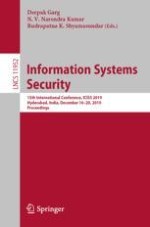2019 | Buch
Information Systems Security
15th International Conference, ICISS 2019, Hyderabad, India, December 16–20, 2019, Proceedings
herausgegeben von: Deepak Garg, N. V. Narendra Kumar, Rudrapatna K. Shyamasundar
Verlag: Springer International Publishing
Buchreihe : Lecture Notes in Computer Science
